We may not have the course you’re looking for. If you enquire or give us a call on +352 8002-6867 and speak to our training experts, we may still be able to help with your training requirements.
We ensure quality, budget-alignment, and timely delivery by our expert instructors.
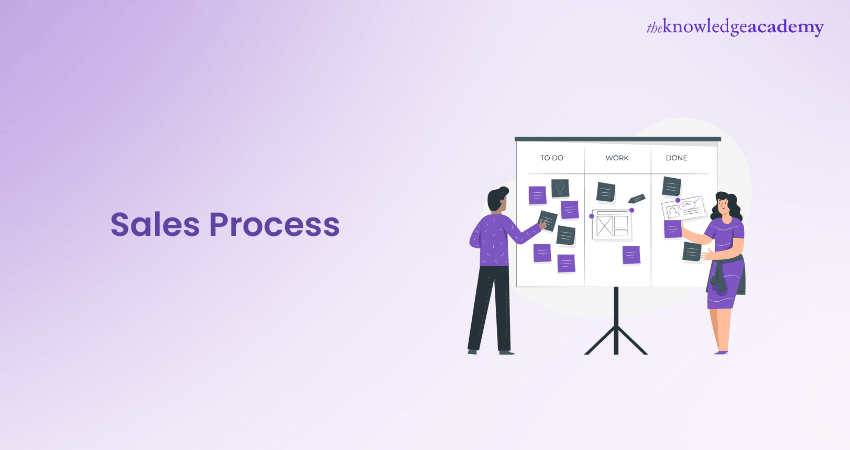
Navigating the world of Sales Process can feel like solving a complex puzzle. Without a clear roadmap, turning leads into loyal customers becomes a daunting task. That’s where a Sales Process comes in – a carefully crafted series of steps that empower businesses from initial contact to closing deals.
Mastering a Sales Process isn't just about making more Sales; it's about creating meaningful connections with your customers, building trust, and offering real solutions. In this blog, we’ll dive deep into a Sales Process, exploring each step, identifying common pitfalls, and sharing strategies to improve your sales approach. Ready to streamline your sales journey? Let’s get started!
Table of Contents
1) What is a Sales Process?
2) Sales Process Steps
3) Sales Process Flowchart
4) How to Improve Your Sales Process?
5) Three Levels of Sales Process
6) Sales Process Examples
7) Sales Process vs Sales Methodology
8) Common Sales Process Mistakes
9) Conclusion
What is the Sales Process?
At the heart of successful business transactions lies the concept of a Sales Process, a meticulously structured sequence of steps that leads organisations to turn prospects into loyal customers. It serves as a strategically-driven roadmap, outlining the journey from initial contact to final conversion. Like a choreographed dance, a Sales Process orchestrates every interaction, communication, selling and negotiation to optimise engagement, maximise conversions, and foster enduring relationships.
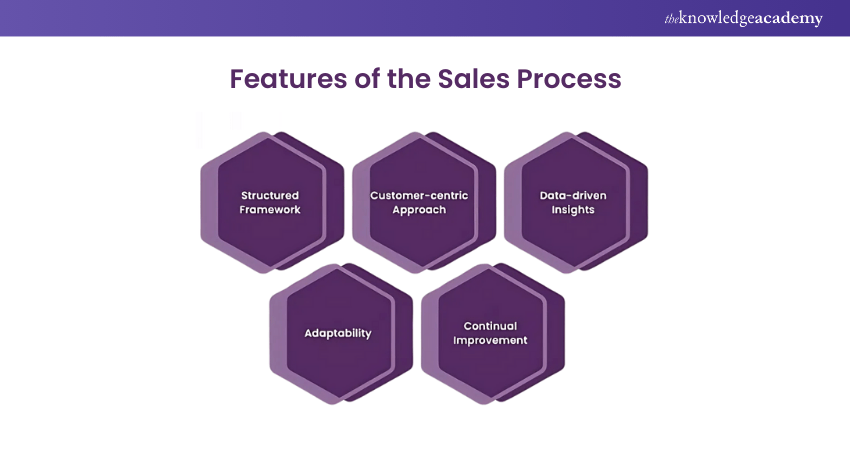
A Sales Process is not a one-size-fits-all formula; rather, it's a customisable framework that adapts to different industries, products, and customer behaviours. It encompasses various stages, each designed to align with the customer's Decision-making journey. This journey typically starts with prospecting – identifying potential leads – followed by a needs assessment, presentation, negotiation, and ultimately, closing the deal.
Throughout this process, the customer is the focal point. Effective Sales Processes involve Active Listening, empathy, and a tailored approach to fulfilling their specific needs and pain points.
In essence, a Sales Process encapsulates the art and science of successful selling. It empowers businesses to navigate the complex ecosystem of customer interactions with purpose and precision. By embracing this structured approach, organisations can enhance customer satisfaction, maximise revenue potential, and create a sustainable foundation for business growth.

Sales Process Steps
This section of the blog will expand on the different steps of the Sales Process:
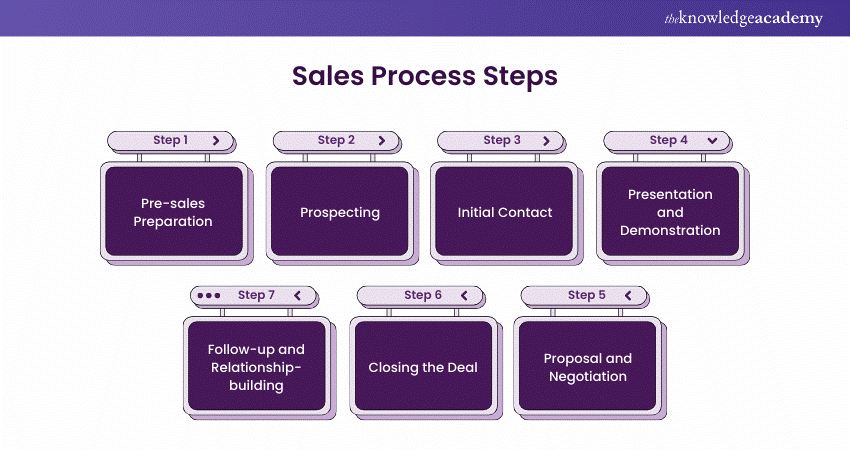
1) Pre-sales Preparation
Sales success starts with comprehensive pre-sales preparation. This crucial stage provides you with the essential resources and information to navigate the Sales challenges successfully.
a) Understand Your Product/Service: Gain a thorough understanding of your offerings, including characteristics, advantages, and distinguishing selling points. This information will allow you to display your product effectively.
b) Identify Your Target Audience: Pinpoint your ideal customers' demographic and psychographic traits through research to identify your target audience. This understanding will assist you in customising your communication to meet their requirements.
c) Create Ideal Customer Profiles: Develop detailed ideal customer profiles by outlining your ideal customers' age, profession, pain points, and buying behaviours. These profiles help shape your marketing tactics.
d) Establish Defined Sales Targets: Determine precise sales goals that align with your company's strategic plan. Specific objectives help direct your actions toward obtaining quantifiable results, such as hitting sales goals or improving customer loyalty.
Ready to accelerate your sales results? Our Sales Training Courses teach you the tools, tactics, and mindset you need to succeed. Sign up today and start improving your skills!
2) Prospecting
Prospecting is the door to your potential clients. By strategically identifying and prioritising leads, you maximise your chances of successful conversions.
a) Lead Generation Strategies: Use both inbound and outbound methods such as curated content, social media campaigns, cold calls, and networking events. This raises your prospect pool and forms multiple engagement touchpoints.
b) Qualifying Leads: Evaluate leads to ensure they match your ideal customer persona. Assess their interests, Budget, decision-making authority, and timeline to determine the most promising leads.
c) Prioritising Leads for Outreach: Apply a tiered approach to focus on leads with higher engagement and potential value, optimising your outreach efforts for better conversion rates.
3) Initial Contact
The first interaction establishes the foundation for a thriving partnership. This is how you can maximise it:
a) Craft a Concise Elevator Pitch: Present a compelling message that showcases the main benefit of your product or service, generating curiosity.
b) Adapt Communication Methods: Adjust how you communicate by utilising the preferred communication method of the prospect, whether it be calls, emails, or direct messages, in order to enhance the likelihood of establishing a connection.
c) Build Rapport and Trust: Establish trust and connection by actively listening and communicating empathetically, demonstrating genuine interest in customer's goals and challenges. This promotes transparent communication and potential cooperation.
4) Presentation and Demonstration
During this stage, you can highlight your product or service by focusing on its value proposition through three important steps.
a) Engage With a Structured Presentation: Lead potential customers through a coherent, rational sequence that directly tackles their problems.
b) Highlight Benefits and Features: Concentrate on distinct qualities that meet customers' individual requirements, boosting engagement and excitement.
c) Address Concerns: Predict and address objections with thoughtful responses, demonstrating your knowledge and dedication.
Learn customer engagement strategies with our Online Sales Training – Register now!
5) Proposal and Negotiation
This step includes presenting a convincing offer and discussing an agreement that benefits both parties.
a) Crafting Proposals: Create a concise proposal outlining the main features, advantages, costs, and conditions of your offer.
b) Pricing Strategies: Ensure pricing reflects value and utilise discounts carefully to uphold product quality.
c) Negotiation Techniques: Work together for mutually beneficial results, practise attentive listening, and find solutions that benefit all parties.
6) Closing the Deal
In the closing phase, you ensure that the customer commits to move forward. Consider these three methodologies:
a) Alternative Choice Close: Provide choices that ultimately result in a purchase (e.g., "immediate payment or monthly instalments?").
b) Extra Inducement Close: Give a bonus, such as a reduced price or complimentary benefit.
c) Standing Room Only Close: Emphasise scarcity or potential cost increase to prompt immediate action.
7) Follow-up and Relationship-building
After closing the deal, it is essential to build and maintain relationships and ensure customer contentment for sustained prosperity.
a) Express Gratitude: Show gratitude by sending a genuine thank-you message to demonstrate appreciation and professionalism.
b) Ensure Satisfaction: Make sure to communicate regularly and show dedication to address any issues and ensure satisfaction.
c) Build Lasting Relationships: Share informative content and insights to position yourself as a trusted advisor for potential business and referrals.
Sales Process Flowchart
A sales Process flowchart is a step-by-step guide that helps salespeople turn leads into customers by mapping out clear actions for every situation. Using "yes" or "no" scenarios, it shows exactly what to do based on the customer’s response, ensuring consistency in how customers are treated.
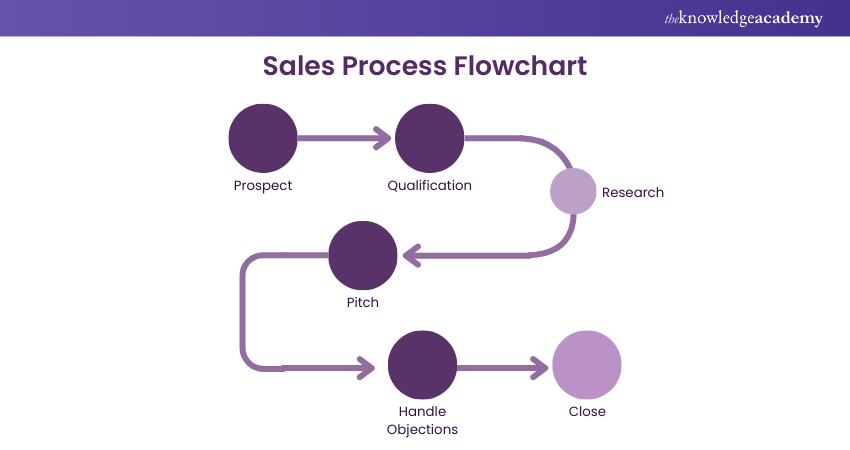
By following the flowchart, your team can stay on track and provide a uniform experience for all customers. Whether it’s simple or detailed, the chart adapts to your needs, making the Sales Process smoother and more efficient.
Elevate your Sales game with our Sales Analytics Training today!
How to Improve Your Sales Process?
A structured and data-driven Sales Process is essential for any organisation aiming to boost revenue consistently. By taking the time to analyse each stage of the sales cycle, you’ll uncover inefficiencies and opportunities for growth. Here are five key steps to guide you toward refining your Sales Process:
1) Analyse Your Current Sales Process
Examine your current Sales Process to identify what works and what needs improvement. Start by observing how sales reps handle deals from prospecting to closing and track each step’s timeline.
Analyse several recent successful deals and work backwards to uncover patterns in communication, follow-up, and closing times. This approach highlights any gaps or inefficiencies, enabling teams to refine their processes for better results.
2) Outline the Buyer’s Journey for Your Target Persona
Understanding a target persona’s buyer’s journey is crucial for shaping a Sales Process that resonates with the right audience. This journey covers the stages a potential customer goes through—from initially discovering your solution to deciding if it meets their needs.
By reviewing marketing analytics, you can learn how leads find your offering, which messages appeal to them, and why they ultimately convert. Running surveys with existing customers uncovers their main concerns, objections, and motives, helping refine both your Marketing and sales strategies for maximum impact.
3) Define the Prospect Action That Moves Them to the Next Stage
Define clear, specific actions that move a prospect from one stage of a Sales Process to the next. These actions should be guided by the prospect’s behaviour—rather than by guesses or assumptions.
Consider asking questions about what motivates a prospect to advance. For example, did highlighting a particular challenge encourage them to schedule a call? Did a specific product feature inspire them to continue?
Identifying these factors helps create a more consistent, predictable, and effective Sales Process.
4) Define Exit Criteria for Each Step of the Sales Process
Define clear exit criteria for each stage of the Sales Process by outlining what needs to happen before moving a prospect to the next step. For example, at the “presenting” stage, a required action might be sharing a testimonial video to confirm that the prospect is ready for “closing.” These exit criteria serve as checkpoints, ensuring that each stage has been fully addressed.
It’s also helpful to specify what information representatives need to know, what actions they should take, and what content they should share at every step. This approach guarantees a consistent, on-brand experience for all prospects while making the Sales Process more structured and predictable.
5) Measure Your Sales Process Results
Keep track of how well the Sales Process works by noting how many prospects move through each step, how long they stay there, and which ones end up closing. For example, record how many leads start in a certain step (like “awaiting demo”) at the beginning of the month, how many are added, how much progress, and how many are left at the end.
Measure other key metrics, such as how long each step takes, which step might slow prospects down, and the percentage that closes after a demo. This information helps pinpoint what’s going well and what needs improvement, making the Sales Process smoother and more effective over time.
Three Levels of Sales Process
Your Sales Process often falls into one of three categories: Humming, Experimenting, or Thrashing. Each category reflects a distinct level of stability and success and offers insights into where your team excels—or needs work. Understanding these levels helps you refine your approach for better sales outcomes.
Level 1: Humming
a) At least 80% of your reps are hitting their monthly sales goals consistently.
b) New hires quickly learn and adapt to the Sales Process with minimal issues.
c) Feedback from the team is largely positive, and everything feels smooth and efficient.
Level 2: Experimenting
a) The team isn’t fully sure what works best, so they keep trying new approaches.
b) They may test different modes of communication or messaging to spark better sales conversations.
c) The goal is to figure out which tactics or strategies lead to better conversion rates.
Level 3: Thrashing
a) The team constantly switches tactics, making it hard to track what really works.
b) Rapid changes lead to confusion and waste effort, with no clear direction.
c) Exiting this stage quickly is crucial, as focusing on a more stable approach prevents chaos.
Sales Process Examples
Sales processes can vary significantly depending on factors like product complexity, sales cycle duration, and the number of stakeholders involved. Below, we explore three distinct examples—each offering its own unique structure and benefits—to help you find the best fit for your business needs.
1) Beyond Business Groups' 7-Step Selling Process
Beyond Business Group adapts the traditional seven-step sales process—popular for addressing objections and following up post-sale—by merging prospecting and lead qualification. Despite this slight modification, the core structure remains intact, ensuring sales reps benefit from additional touchpoints with potential clients.
These extra interactions can be a significant advantage when moving toward closing a deal, allowing reps to address concerns thoroughly and confirm the value of their offering.
A Seven-Step Sales Process Is Best For
The seven-step approach is ideal for B2B products and services that are evaluated by multiple stakeholders or departments. The process’s extended timeline lets the decision-making team interact with the salesperson, request demonstrations, and provide feedback, ultimately leading to a more informed and confident purchasing decision.
2) Ring Central's 6-Step Sales Process
RingCentral’s sales process uniquely condenses the traditional approach into six steps, clearly outlining both the salesperson’s responsibilities and the customer’s actions at each stage.
This shorter framework does not split inbound and outbound prospecting into separate steps, and it doesn’t include a follow-up phase after closing the deal. As a result, it streamlines the selling experience, allowing businesses to engage prospects quickly ficiently.
The Six Step Sales Process Is Best For
The condensed timeline makes it ideal for B2B and B2C companies that need less customer interaction before finalising a purchase. For products or services with shorter life cycles or fewer required touchpoints in the Decision-making Process, a leaner approach can optimise sales efforts without compromising efficiency.
3) Zendesk's 5-Step Sales Process
Zendesk’s five-step sales process is the shortest of the three approaches, focusing on the most critical touchpoints from start to finish. With fewer steps, research and objection handling take a back seat. Instead, reps concentrate on qualifying prospects early on and swiftly move to the pitch to secure the sale.
The Five-Step Process is Best For
This streamlined approach is suitable for B2B products and services that involve only a small group of Stakeholders or are purchased infrequently (e.g., vehicles, appliances, or life insurance). Sales reps can devote their energy to a single point of contact, accelerating the path to closing the deal.
Boost your confidence with our top Sales Interview Questions. Prepare to impress and land your next sales role with ease!
Sales Process vs. Sales Methodology
Sales Process and Sales Methodology are closely related; however, they differ in various aspects. Here’s a distinction between the two.
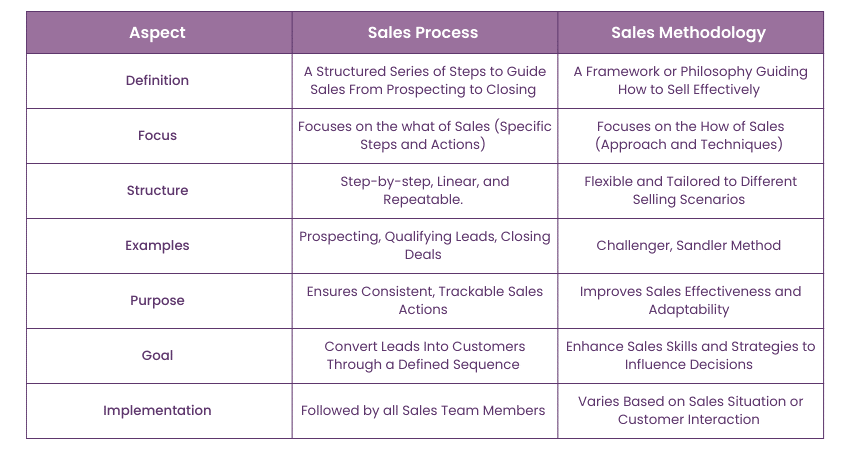
Common Sales Process Mistakes
Given below are the most common Sales Process mistakes you must avoid when it comes to developing an effective Sales Process for your customers and team:
1) Vague Sales Process Steps: Clearly specify all the steps and actions that advance potential customers. Without clear cues, sales representatives could misunderstand what's working, resulting in mishandling of the process. Record and rehearse these procedures with your group.
2) Relying on one Sales Methodology: There is no one method that can solve all problems perfectly. Mixing elements from different approaches while staying informed on changes in customer behaviour and sales trends can be advantageous.
3) Viewing a Sales Process as Static: A Sales Process is an ongoing process. Regularly check in with reps and measure success to determine areas for improvement.
4) Misaligning Sales Plays with the Process: Make sure that your sales strategies align with your procedure. Record the tasks for every phase, like particular emails for reaching out to potential clients, and keep them in a collaborative sales playbook.
5) Excluding Marketing: Ensure that marketing is kept up-to-date on sales insights, including high-performing sectors and potential clients. Collaboration enables marketing to deliver superior leads and content and provides nurturing assistance at every stage.
6) Focusing Solely on Closing Deals: While closing is vital, the process should prioritise delivering value. Research the customer's needs to provide solutions, not just push for sales.
7) Not Measuring KPIs: Monitor key sales metrics to gauge success and refine your process. Gauging KPIs like deal closures can highlight both progress and areas needing enhancements. Tools like sales dashboards can automate this tracking.
Conclusion
A Sales Process is a dynamic and continuous journey that involves a continuous series of well-defined steps. Each phase, from pre-Sales preparation to continuous improvement, contributes to building relationships, driving revenue, and sustaining business growth. By understanding and mastering each step, you can enhance your ability to effectively connect with prospects, address their needs, and establish enduring partnerships. Remember, the key lies in meticulous planning, strategic execution, and a commitment to constant enhancement.
Learn Sales marketing strategies with our Sales Management Training – Register today!
Frequently Asked Questions
Why is the Sales Process Important?

The Sales Process is important because it gives a structured framework, ensures consistent customer interactions, streamlines workflows, and identifies areas for improvement. Well-defined steps help address customer needs and close deals effectively.
How Does the Sales Process Differ Between B2B and B2C?

B2B sales often involve multiple decision-makers, longer sales cycles, and a heavier focus on building relationships and demonstrating ROI. B2C sales typically have fewer stakeholders, shorter cycles, and rely more on emotional drivers and simpler decision-making processes.
What are the Other Resources and Offers Provided by The Knowledge Academy?

The Knowledge Academy takes global learning to new heights, offering over 3,000 online courses across 490+ locations in 190+ countries. This expansive reach ensures accessibility and convenience for learners worldwide.
Alongside our diverse Online Course Catalogue, encompassing 19 major categories, we go the extra mile by providing a plethora of free educational Online Resources like News updates, Blogs, videos, webinars, and interview questions. Tailoring learning experiences further, professionals can maximise value with customisable Course Bundles of TKA.
What is The Knowledge Pass, and How Does it Work?

The Knowledge Academy’s Knowledge Pass, a prepaid voucher, adds another layer of flexibility, allowing course bookings over a 12-month period. Join us on a journey where education knows no bounds.
What are the Related Courses and Blogs Provided by The Knowledge Academy?

The Knowledge Academy offers various Sales Courses, including the Sales Negotiation Training, Sales Management Training, and Closing Sales Training. These courses cater to different skill levels, providing comprehensive insights into Sales Strategy.
Our Business Skills Blogs cover a range of topics related to Sales, offering valuable resources, best practices, and industry insights. Whether you are a beginner or looking to advance your Business skills, The Knowledge Academy's diverse courses and informative blogs have got you covered.
Upcoming Business Skills Resources Batches & Dates
Date
 Sales Bootcamp
Sales Bootcamp
Fri 14th Mar 2025
Fri 9th May 2025
Fri 11th Jul 2025
Fri 12th Sep 2025
Fri 14th Nov 2025






 Top Rated Course
Top Rated Course


 If you wish to make any changes to your course, please
If you wish to make any changes to your course, please


